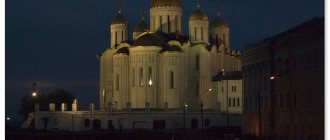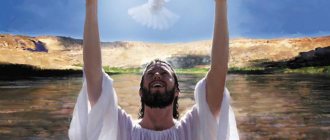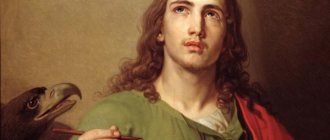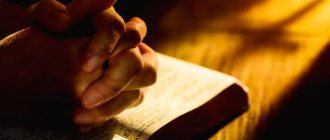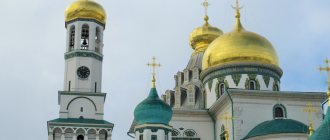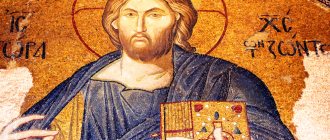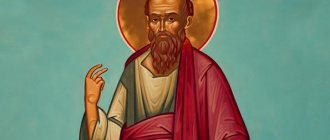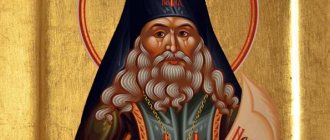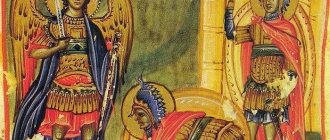No matter how people strive to delay the Day of Judgment, everything is inevitable. The religion of Christianity not only recognizes human life on earth, in a bodily shell, but also does not deny existence after death. The creation of the world and its last days, the Bible tells people about this too. She prophesies soon the Second Coming of Jesus Christ, which will divide people into two: the righteous who will go to heaven and the sinners who will face appropriate punishment.
The coming phenomenon is described not only in the Holy Scriptures. The subjects of icons are often dedicated to him. The depicted images demonstrate pictures of what is happening on the Day of Judgment and such icons are found in most churches in Russia. Each icon of the Last Judgment has a different design, but they are always united by one thing - composition and scenes, subject to generally accepted canons.
Words of the Saints
According to historical data, in various sacred scriptures there are many legends about this process, and about the act itself, since various saints of one century or another speak about it.
It is known that the Holy Image was held in the hands of modern shrines, who spoke about it because they saw with their inner eyes the consequences of various sinful acts or loss of spirit. Saint Theophan the recluse said that humanity must be prepared for the second coming of the Almighty. He believed that such an event would certainly happen, but he did not know the exact date, so humanity must be prepared, for this it is necessary to visit churches in order to receive communion and repent.
Famous Saint John believed that it is not worth guessing the exact date of the occurrence of such an act, but there are many different omens of the beginning of the end. As you know, such omens are various diseases and misfortunes, as well as famine, war and multiple destructions. The saint also believed that before the end of humanity begins to change, and God’s laws will go into existence, at that very moment many different sinful acts will be committed and evil will descend on the world.
Thus, we can say that not a single Saint remained indifferent to the overall composition, which depicts in detail the Heavenly bliss of the righteous and the Hellish torment of sinners who fall into the hands of Satan.
Description
It is important to note that experts have determined that the image depicted on the icon is rich in a variety of characters and a quick change of events. Currently, you can find a large number of different descriptions of the icon, since it consists of at least three registers, each of which has its own place.
At the top of the Holy Face is depicted Jesus Christ, on both sides of him are the apostles, who, together with the Almighty, participate in the process of evaluating deeds. On the lower part of the Holy image there are angels who allegedly trumpet and call everyone.
Below, under the image of the Almighty, there is an etimasia. As you know, this is a kind of judge’s throne, on which are located: a sponge, a cane, a spear and the Gospel. Knowledgeable people claim that etomasia is the main detail of this composition, and over time, based on various information, it becomes a kind of independent symbol.
The lower part of the image on the icon reveals the story of what will happen to a righteous or sinful person after he undergoes the terrible Divine judgment. After this, the icon is supposedly divided, therefore, on the right side of the Almighty you can see the righteous who are heading to heaven, and this is also where the angels, the Garden of Eden and the Mother of God are located. On the left side of Jesus Christ are depicted sinners, demons, the gates of hell, and even Satan himself.
Icon and painting of Vasnetsov
In the past, the theme of the Last Judgment often worried not only church artists, but also secular ones. For example, there is an icon with a similar plot, painted by Viktor Vasnetsov. This artist, as you know, showed himself most clearly in the epic fairy-tale genre. It was his brush, for example, that produced such famous paintings as “Alyonushka”, “Bogatyrs”, “Flying Carpet”.
However, religious painting also occupied a fairly important place in the life of this artist. The painting “The Last Judgment” (oil on canvas) was created by him in 1904 for the St. George Cathedral in the city of Gus-Khrustalny
As many other famous artists believe, it turned out to be very expressive, but somewhat overloaded with details. And indeed, unlike the images of icon painters, there is practically no free space in this essentially secular picture. Human figures, Christian attributes, etc. occupy absolutely the entire space on it.
Another grandiose work on the theme of the Last Judgment belongs to the brush of Vasnetsov. It was this subject that the artist chose to paint one of the walls of the Vladimir Cathedral in Kyiv in 1885.
Last Judgment in Christianity
In the Old Testament, the idea of the Last Judgment is presented as the “day of Yahweh” (one of the names of God in Judaism and Christianity). On this day there will be a celebration of victory over earthly enemies. After the belief that the dead could be resurrected began to spread, the “day of Yahweh” began to be perceived as the Last Judgment. The New Testament states that the Last Judgment is the event when the Son of God will descend to earth, sit on the throne and all nations will appear before him. All people will be divided, and the justified will stand on the right hand, and the condemned on the left.
- Jesus will entrust part of his powers to the righteous, for example, the apostles.
- People will be judged not only for good and evil deeds, but also for every idle word.
- The Holy Fathers said about the Last Judgment that there is a “memory of the heart” in which all life is imprinted, not only external, but also internal.
Why do Christians call God's judgment “terrible”?
There are several names for this event, such as the great day of the Lord or the day of God's wrath. The Last Judgment after death is so called not because God will appear before people in a terrifying guise; on the contrary, he will be surrounded by the splendor of his glory and greatness, which will cause fear in many.
- The name “terrible” is due to the fact that on this day sinners will tremble because all their sins will be made public and they will have to answer for them.
- It is also frightening that everyone will be judged publicly in front of the whole world, so it will not be possible to evade the truth.
- Fear also arises due to the fact that the sinner will receive his punishment not for some time, but forever.
Meaning in Orthodoxy
Currently, there are many very important and significant icons in the Orthodox Christian faith, but the Last Judgment icon occupies a special place.
It is important to know that the Holy Image depicts scenes that are possible if the second coming of Jesus to earth occurs. Orthodox Christians believe that it is at this moment that every person on the planet will come to give an answer to the Almighty and will receive what they deserve based on their actions and deeds on worldly earth. recommended reading
- "SIGN" ICON OF THE MOTHER OF GOD
The plot of the icon[edit | edit code]
Main article: Last Judgment
During the Last Judgment, everyone who has ever existed, living and dead, will be resurrected in the flesh. They will be judged by Jesus, and each will deserve a sentence in accordance with their earthly deeds - either eternal bliss in heaven or eternal torment in hell (Matthew,).
Textsedit | edit code
In its developed form, the iconography of the Last Judgment is based on the texts of the Gospel, the Apocalypse, as well as patristic works: the “Words” of Ephraim the Syrian, the Words of Palladius Mnich, the Life of Basil the New and other works of Byzantine and Old Russian literature; in the next period, texts of folk spiritual poems can also be seen in iconographic details.
- One of the most important sources that influenced the composition and character of the compositions of the Last Judgment was the Life of Basil the New (10th century).
- Vision of the Prophet Daniel (Dan.) - in the scene “Vision of the Prophet Daniel” an angel shows the Prophet Daniel four animals. These beasts symbolize the “perishing kingdoms” (kingdoms that are about to perish) - Babylonian, Macedonian, Persian and Roman, or the Antichrist. The first is represented in the form of a bear, the second in the form of a griffin, the third in the form of a lion, and the fourth in the form of a horned beast. Sometimes other animals were also written that had an allegorical meaning. Among the latter, hares are especially interesting, which, according to a widespread idea in Rus', embodied in poems about the “Pigeon Book,” were allegorical images of truth (white hare) and “falsehood” (gray hare).
- The fiery stream (river) is known from the so-called “Walking of the Mother of God through torment,” one of the most popular apocrypha in ancient Russian writing. In the lists of the “Walk”, starting from the 12th century, it is indicated that “ in this river there are many husbands and wives;
some are immersed to the waist, others to the chest, and only others to the neck ,” depending on the degree of their guilt.
Purposeedit | edit code
The images of the Last Judgment had an important feature: they were created not to intimidate a person, but to make him think about his sins; “ do not despair, do not lose hope, but begin to repent
" Repentance as an indispensable condition for achieving the Kingdom of God is one of the fundamental provisions of Christian doctrine, and this problem was especially relevant at the turn of the 11th-12th centuries, the time when the plot penetrated into Rus'.
Byzantine mosaic "Last Judgment", 12th century (Torcello)
Interpretation
Over the years, the Holy Image has had many different interpretations, some people find it creepy, others are afraid, and Orthodox Christian believers see a different meaning in it. Since it is the believing parishioners who know that, according to the plan of the Almighty, certain actions of a person who lives on worldly earth will subsequently be considered, where Jesus Christ himself will be the chairman, and will happen, such an act must certainly occur during the second coming of God’s son.
After the trial, a person will be shown a straight road that will take him either to hell in the hands of Satan, or to heaven to the Almighty and his mother, as well as to the guardian angels. Consequently, everyone will be rewarded according to their deeds and deeds. According to church history and beliefs, such an event will dominate the renewal of the world, therefore, the human soul will forever unite with the Almighty or go to Satan forever.
However, Orthodox Christian believers and ministers of churches and monasteries claim that the composition of the Judgment Day icon is depicted not in order to frighten a person, but so that everyone in this mortal world thinks about their own actions, deeds and sinful accomplishments. Worshipers claim that many people, after seeing the image, fall into despair and lose hope, but this should not be done. Temple servants advise such people to come to the temple of God, confess and repent, take communion and begin to change their own lives, so that at the divine judgment they do not go into the terrible hands of Satan.
History of addition
Icon painters began depicting scenes of the Last Judgment a very long time ago. The first paintings and images of this type appeared in Byzantium. For example, several similar icons and temple paintings dating back to the 4th century are known. At that time in Byzantium, such images usually described the parables of the separation of sheep and goats, as well as of the ten virgins.
Icon “The Last Judgment”, late 14th – early 15th centuries (Moscow, Assumption Cathedral)
The canonical plot of the Last Judgment was also formed in Byzantium, around the 18th century. In Rus', such icons began to be painted almost from the very baptism. But the very first such image was recorded by historians on the walls of the Kyiv Cyril Monastery. Somewhat later, scenes of the Last Judgment appeared in the Dmitrov Cathedral, the Church of the Savior Nereditsa and the St. George Church.
We advise you to study Prayer according to the agreement for the health of the sick
Topic 1. The second coming of Jesus Christ. The Savior is the dominant feature of the icon. He can often be seen surrounded by the Mother of God, John the Baptist, angels or apostles. Jesus Christ acts as a judge who divides people into righteous and sinners.
Topic 2. Renewal of the world. These are various signs of change. Here angels fight demons and blow trumpets, unclean spirits and sinners burn in fiery hell, and souls line up before the judgment seat. The dead are rising everywhere. The allegorical earth in the form of a woman disgorges the dead, and birds and fish do the same.
Topic 3. Heavenly Jerusalem. Almost always the city in which the righteous live is depicted at the top. Some are just heading there and are depicted in flight. Usually these are schema-monks. Angels are hovering everywhere, and two of them are rolling up a scroll (the sky) - this is a symbol of the end of the world.
As for Mother Rus', the Last Judgment icon began to appear almost immediately after baptism. Historians call the first monastery where this icon was noticed the St. Cyril Monastery. Later it was noticed that the plot of the icon was completely divided into the court scene and the image of the Apocalypse, which became the reason for their official separation.
The earliest icons depicted not only the trial itself, but also scenes from the Apocalypse. Later these two stories were separated. Initially, the canons determined only which scenes should be depicted in the image. The icon painters chose their location themselves. The plot and composition were fully approved by the Church only in the 16th-17th centuries. By this time, each scene of the Last Judgment had taken its place on the icons.
Texts that influenced the iconography of the Last Judgment
In the developed form, the iconography of the Last Judgment is based on the texts of the Gospel, the Apocalypse, as well as patristic works: the “Words” of Ephraim the Syrian, the Words of Palladius Mnich, “The Life of Basil the New” and other works of Byzantine and Old Russian literature; in the next period, texts of folk spiritual poems can also be seen in iconographic details.
- One of the most important sources that influenced the composition and character of the compositions of the Last Judgment was the Life of Basil the New (10th century).
- Vision of the Prophet Daniel (Dan. 10-12) - in the scene “Vision of the Prophet Daniel,” an angel shows the prophet Daniel four animals. These beasts symbolize the “perishing kingdoms” (kingdoms that are about to perish) - Babylonian, Macedonian, Persian and Roman, or the Antichrist. The first is represented in the form of a bear, the second in the form of a griffin, the third in the form of a lion, and the fourth in the form of a horned beast. Sometimes other animals were also written that had an allegorical meaning. Among the latter, hares are especially interesting, which, according to a widespread idea in Rus', embodied in poems about the “Pigeon Book,” were allegorical images of truth (white hare) and “falsehood” (gray hare).
- The fiery stream (river) is known from the so-called “Walking of the Mother of God through torment,” one of the most popular apocrypha in ancient Russian writing. In the lists of the “Walk”, starting from the 12th century, it is indicated that “ in this river there are many husbands and wives;
some are immersed to the waist, others to the chest, and only others to the neck ,” depending on the degree of their guilt.
The images of the Last Judgment had an important feature: they were created not to intimidate a person, but to make him think about his sins; “ do not despair, do not lose hope, but begin to repent
Repentance as an indispensable condition for achieving the Kingdom of God is one of the fundamental provisions of Christian doctrine, and this problem was especially relevant at the turn of the 11th-12th centuries, the time when the plot penetrated into Rus'.
Orthodox wedge
Author: Bishop Nikolai of BalashikhaI foresee a terrible day, fearing that I will sit before you to judge the living and the dead. (Canon for the Week of the Last Judgment)
The liturgical texts of Meat Week about the Last Judgment - in contrast to the “softer”, less categorical texts of the two preceding weeks preparatory to Great Lent - from the very first lines reveal to the worshipers a majestic and menacing picture of the end of the universe - that terrible day of judgment about which no one does not know, only God the Father knows.
Signs of the approach of this day are spoken of both in the Gospel and in the Revelation of St. Apostle John the Theologian. The Apocalypse speaks about the future events of the end of the world and the Last Judgment in secret, in images, but in patristic interpretations, liturgical texts, and especially in iconography, the picture of the future becomes quite clear. “When you want to come to create righteous judgment, Most Righteous Judge, a terrifying river of fire draws everyone before Your judgment seat...”; “The books will unbend, the deeds of men will be revealed...”; “The trumpets will sound, and the graves will be exhausted... those who have sinned will tremble, weep more fiercely, and we will be sent into torment”; “Eternal fire, pitch darkness and tartarus, a fierce worm, and the gnashing of teeth and unceasing…” (verses on the Lord, I cried) – the Church tried not only to describe these future events of the Judgment of God, but also to show them.
Of course, like all other observances of the Lenten Triodion, the service of the Week of the Last Judgment has the goal of spiritually awakening the Christian, reviving his prayer work, and leading to repentance: “But, the only Savior who loves mankind, the King of the ages, before even death comes, having turned to repentance, have mercy me" (to the Lord, I cried Glory:). The icons of the Last Judgment, which became widespread in the 8th century, also serve the same purpose; Some details of the painting of the Last Judgment were already known in the 4th-6th centuries. [Pokrovsky, Gospel]. Iconography of the Last Judgment for the 15th century. can be considered fully developed. Speaking about the development of the iconography of the Last Judgment, I would like to quote the words of N.P. Kondakov that the Orthodox iconographic tradition has learned from ancient times the main theological themes and follows them, constantly revealing new aspects in them [Kondakov, Iconography].
...This note continues the topic started; it talks about some rare icons of the Last Judgment that are in domestic and foreign museum collections.
It is interesting to observe the development of the iconography of the subject that interests us in comparison with the “classics of the genre”, the oldest that has come down to us - the icon of the Last Judgment in the Assumption Cathedral of the Moscow Kremlin (the first half of the 15th century).
Icon of the Last Judgment, painted by a Pskov master in the first half of the 16th century. for the Annunciation Cathedral in the city of Solvychegodsk (now located in the local historical and art museum), is a complex multi-figure composition of established iconography.
In the highest register of the composition, in the middle is the God of Hosts; He sits in a cloudy circle on a throne surrounded by the Heavenly Host. The location of the Lord of Hosts and the entire upper register are highlighted by several tiers of clouds. On the right side of the upper register, the composition of the Lord of Hosts sitting on the throne is repeated; He sends His Only Begotten Son to perform a sacrificial deed to save the human race. According to some interpretations, this part of the composition means that God the Father sends His Son to judge the human race. A little higher are the angels of God twisting the heavens, and to the right are the angels casting demons into the underworld. On the opposite side of the icon are the venerable fathers rising like angels into the Kingdom of Heaven. At the right hand of God the Father is depicted the Jerusalem above; in it are the righteous, blessed by the Heavenly Father, inheriting the kingdom prepared from the foundation of the world (cf. Matthew 25:34). These are saints of different ranks, sitting in groups of three at oval or rectangular tables laden with dishes. The arched openings of the wall of the Upper Jerusalem are guarded by seraphim.
In the central part of the icon is the Judge Christ sitting on the throne; The Mother of God and the Forerunner, the preacher of repentance, stand before Him with prayerful intercession for the human race. This element of the icon represents the Deesis included in the composition. Just below are the kneeling ancestors: Adam near the Blessed Virgin, Eve - from the side of John the Baptist. On either side of the central group are depicted seated apostles - six on each side; open books in their hands. There are angels behind the apostles.
The register below depicts the nations marching to the Judgment: the saints and righteous are located on the right hand; on the left side, pagans and foreigners approach the Judge - their nationality is evidenced not only by the corresponding inscriptions, but also by their characteristic clothes. The first group (the Jews) is led by Moses, who points his charges to Christ.
In the center of this register is the Prepared Throne with all its characteristic features; this is the throne about which the Psalmist prophetically proclaimed: You have executed my judgment and my litigation; You have sat on the throne, righteous Judge. You were indignant with the nations, you destroyed the wicked, you blotted out their name forever and ever (Ps. 9:5, 6).
All other elements of the composition are also worked out in detail: the right hand of God holding the souls of the righteous - they are shown in the form of swaddled babies, the souls of the righteous are in the hand of God, and torment will not touch them (Wis. Sol. 3:1). The angels standing at the Prepared Throne meet the nations going to Judgment; in their hands they hold scrolls with the text of the Gospel read at the Liturgy on Meat Sunday. The scroll of the angel meeting the righteous is triumphantly directed upward, as if showing them the way straight to the Heavenly Jerusalem. Another angel has gospel words on a scroll addressed to those who have not shown mercy.
The next register is represented by four spheres, in which the following compositions are placed: the Mother of God sitting on the throne with the angels present; vision of the prophet Daniel - an angel points him to four beasts, symbolizing the “perishable kingdoms”. The last area is dedicated to the plot "Earth and sea give up the dead." In the center of the sphere is a woman personifying the earth, and around are people rising from the dead. At the bottom of the sphere is an allegorical image of the sea - a figure holding a ship on his shoulders.
In the lower right part of the icon there is depicted hell - fiery Gehenna, in the center of which Satan sits. Below are the marks in which sinners are tormented for their sins. The peculiarity of the image of the underworld is that it is depicted as a massive rock over which hellish flames rage. In the rock there are dark caves with sinners.
On the left side of the lower register of the icon is depicted paradise: Abraham’s Bosom; standing behind is a prudent robber. A procession of righteous people with the Apostle Peter at their head is moving towards the locked gates of heaven (guarded by a fiery cherub - Gen. 3:24). The first in this long procession are the apostles, and immediately behind them are the high priests of Moscow.
On the icon of the mid-16th century. from Kargopol, which is in the collection of the State Hermitage, more attention is paid to the ordeals.
As in the previous icon, all the main elements of the traditional iconography of the Last Judgment are presented here. The features of this composition include such details as the image of a “merciful fornicator” tied to a pole between hell and heaven (according to legend, he was not allowed into heaven because he indulged in fornication, but he also escaped the torments of hell because he constantly gave alms). Another important detail: Satan, sitting on a beast in hellfire, holds the soul of Judas in his hands.
Scenes of the torment of sinners in hell are presented on ten marks that occupy the entire lower register of the icon. The Kargopol icon presents a detail that is not typical for traditional iconography and is known only in late Russian icon painting: it is a serpent rising from the fiery mouth of the hellish beast to the feet of the forefather Adam: I will put enmity between you and between your wife, and between your seed and between her seed; it will bruise your head, and you will bruise its heel (Gen. 3:15). Twenty rings with allegorical images of ordeals are strung on the serpent - the human soul goes through them before it enters the Kingdom of Heaven.
Another characteristic of the 16th century. detail - a detailed illustration of the visions of the prophet Daniel (Dan. 7–8). Daniel himself and the angel interpreting his visions are depicted on the right side of the icon in a circle near the right margin. They seem to be watching a picture of the Last Judgment.
At the top of the icon on the right are the God of Hosts and Jesus Christ sitting on the throne. In the center of the icon is the Savior seated on the throne in glory. With his right hand He blesses, and with his left He holds the open Gospel with the text: Judge not according to their appearance (John 7:24).
The icon of the late 16th century, painted by the Cretan master George Klotsas, contains a huge number of characters.
There are so many of them that it is quite difficult to single out the main ones, with the exception of Christ depicted at the very top in glory, sitting on the throne. Below is the Prepared Throne, from under which flows a river of fire, descending into fiery Gehenna. On the sides of Etymasia there are two groups of angels holding open books with gospel texts or trumpeting: I saw seven Angels who stood before God; and seven trumpets were given to them (Rev. 8:2).
The left side of the composition depicts the righteous going to Judgment. They occupy three registers, but, despite the large number, they are quite recognizable, because they are equipped with characteristic attributes: Moses has tablets, Psalmist David has a psalter, Noah is depicted with an ark, and tiny Isaac standing next to Abraham holds a bundle of firewood.
In the lower part of the icon on the left are depicted those rising from their graves to the Judgment. This part is especially naturalistic, somewhat reminiscent of Bosch’s paintings. On the right side, Archangel Michael with a sword casts sinners into hell. Their bodies are immediately picked up by demons and sent further into the abyss. The sinners suffering in hell are depicted very naturalistically - this was unacceptable for the Russian tradition.
Against the background of a fiery river, at its very bottom, the prophets David and Ezekiel sit on cloudy seats; they hold tablets with texts about hellish torment and the resurrection of the dead.
The icon is beautifully painted, it contains a lot of details of a narrative nature, and the impression from it is twofold: you can look at it for a long time and with great interest, but at the same time there is no clear call to repentance in it. The icon is kept in the collection of the Museum of the Greek Institute of Byzantine Studies in Venice.
Another Cretan icon from the same museum was painted in the mid-17th century.
The composition is much simpler, but it has a number of innovations: the Prepared Throne is absent, instead there is the Calvary Cross, which is surrounded by angels holding open books. Just below stands the Archangel Michael with a sword and scales.
In the lower part of the composition there is an unusual detail: the righteous approaching the heavenly abodes are met at the open doors of heaven by the Savior Himself in the image of the Great Bishop.
At the other gate the Mother of God is depicted. There is another gate, however, it is located on the border with fiery Gehenna. They depict the customer of the icon, nun Eugenia from Trebizond.
Icon of the Last Judgment, 2nd half of the 17th century. (Icon Museum in Recklinghausen) is a complex composition that includes all the elements of the developed iconography of this subject. The peculiarities of this icon include a large number of inscriptions - not only in the margins, but also across the entire surface of the icon board. An interesting detail: by the seventeenth century, Russia had fairly stable trade, and not only trade, ties with foreign countries. Therefore, that detail of the composition where sinners going to God’s Judgment are represented and where various kinds of foreigners have long been placed is written very expressively. The clothes worn by foreigners are not only exotic, but also ethnographically quite accurate.
There is information that in many Russian cities - Moscow, Vologda, Veliky Novgorod - in the 17th century. On Meat Week, religious processions were held with a festive icon “in order to pity the hearts of rich people with a reminder of the Last Judgment” [Felmy]. “Having understood the Lord’s commandments, let us live like this: we will feed the hungry, we will give drink to the thirsty, we will clothe the naked, we will bring in strangers, we will visit the sick and those in prison, so that He who will judge the whole earth may also say to us: Come, blessed of My Father, inherit the Kingdom prepared for you” (stichera on lithium, Slava :).
In conclusion, about another icon of the Last Judgment, painted at the turn of the 18th-20th centuries. in the Vologda province.
In terms of its visual means, it resembles a popular print, and the abundance of inscriptions further enhances this impression. In this case, the excess information does not transform into a new quality. Even sinners doomed to torment, unlike previous expressive images, here do not cause concern to the conscience.
Turning to the history of the iconography of the Last Judgment, you understand that the expressive compositions of the 15th-16th centuries. and today they encourage worshipers to think about the importance of repentance and the urgent need for works of Christian mercy, without which “spiritual spring”—Lent—is impossible.
In the rapid passage of time, we simply do not have the right to neglect the unique opportunity that the Church provides us here.
His Holiness Patriarch Kirill, characterizing the features of our time, said: “The difference between this time and all previous ones is in its certain apocalyptic tension, for the power of sin has never dominated the human race as it dominates today. And we know that where sin triumphs, there the devil appears. And we know that if sin wins on the scale of the human race, then the Antichrist appears. Therefore, the Church cannot help but react to the increase in evil, no matter how some journalists, publicists, and politicians rebuff it, asking with bewilderment why the Church is invading those areas that are supposedly not its areas - and this is in response to the Church’s concern for so that marriages do not break up, so that the number of abortions decreases, so that people learn to dress decently, so that there is no unbridled domination of carnal sin in human life! We will be scolded in the future, and we are ready for this, because the Church cannot have any other word other than what it proclaims: repent, for the Kingdom of God is at hand (see Matt. 3:2). And today this word should sound especially strong.”
The Church considered its holy icons, including the icons of the Last Judgment, to be such an effective call to repentance.
Sources and literature: Antonova V.I., Mneva N.E. Catalog of Old Russian painting of the 11th - early 18th centuries. (State Tretyakov Gallery). T. 1-2. M., 1963. Icons of the Stroganov estates of the 16th-17th centuries. M., 2003. Kazanaki-Lappa M. Heritage of Byzantium. Collection of the Museum of the Greek Institute of Byzantine and Post-Byzantine Studies in Venice. M.-Venice, 2009. Kondakov N.P. Facial iconographic original. T. 1. Iconography of the Lord our God and Savior Jesus Christ. St. Petersburg, 1905. Kulikova O. V. Ancient faces of the Russian North. From the museum collection of icons of the XIV-XIX centuries. city of Cherepovets. M., 2009. Lazarev V.N. History of Byzantine painting. T. 1-2. M., 1986. Ovchinnikov A. N. Symbolism of Christian art. M., 1999. Pokrovsky N.V. The Gospel in iconographic monuments, mainly Byzantine and Russian. M., 2001. Pokrovsky N.V. The Last Judgment in the monuments of Byzantine and Russian art. — Proceedings of the VI Archaeological Congress in Odessa. T. III. Odessa, 1887. Lenten Triode. Felmy K.H. Icons of Christ. M., 2007.
From the site www.mepar.ru
The Last Judgment Author: Archpriest Boris Balashov A week before Lent, the Church puts everything in our lives in its place: we look into our future, into the outcome of our lives. How will he be appreciated by God? By what criteria?
Waiting to meet God Author: Irina Filippova Conversation with priest Alexander Soyuzov. Time is inexorable. Sometimes it seems that its course is incredibly stormy, and sometimes the passage of time seems to slow down, and a person begins to think that he will live on earth forever. But in both cases, the end is unchanged - bodily death, eternal life of the soul and meeting with Christ. The moment will come when all people - both living and dead - will appear before God. And this will happen at the end of time, on the day of the Second Coming of Christ, on the day of the Last Judgment. What awaits people then?
Reproduction on the Internet is permitted only if there is an active link to the ORTHODOX WEDGE website. Reproduction of site materials in printed publications (books, press) is permitted only if the source and author of the publication are indicated.
In which temples is the shrine located?
In the Moscow region there are two myrrh-streaming icons of Our Lady of the Seven Arrows. The first is located in the Church of the Archangel Michael in Moscow.
The second image is kept near Moscow in the village of Bachurino. The history of the second shrine is quite interesting. The thing is that this image is printed. It was printed for Margarita Vorobyova, but the owner noticed that the face of the Mother of God was streaming myrrh. After this, it was handed over to the church and recognized as miraculous. Recently, the image has been taken to various churches in Russia and abroad.
Another image is located in the Church of St. Lazarus the Righteous in the city of Vologda. The face of the Mother of God occupies one of the important places in the local church. It has been in this place since 1945. Previously, the icon was miraculously revealed in the Church of St. John the Evangelist. Today, pilgrimages take place here twice a year.
One of the lists of the shrine "Softening Evil Hearts" is in the Chapel of Venice. She came to Italy after the events associated with the Great Patriotic War. In 1942, not far from Belogorye (Voronezh region) near the Don, troops of the allied Italy fought against the German coalition. Italian soldiers, in a house destroyed by a bomb, found the surviving icon “Softening Evil Hearts.” This image was given to the Italian priest Policarpo.
The best article for you, go to: Icon of Blessed Xenia of St. Petersburg
Local residents said that it was previously the property of the Resurrection Belogorsk Monastery. The Italians gave the shrine a new name, “Madonna del Don,” but this image had nothing in common with Our Lady of the Don. A year later, the Italians were defeated, and the priest fled with the image to Maistre, where a chapel was built for the miraculous icon. Many Slavs came to this place to mourn those killed in World War II.
Another list is located in the city of Zhizdra, Kaluga province. The icon is of the same type, and in the description it is listed as “Simeon’s Prophecies”. It is slightly different from “Seven Shots” and “Softening Evil Hearts” in that in it the Mother of God covers herself from seven swords with one hand, and holds her baby with the other. The image reads the following words: “And a weapon will pierce your very soul.”
What helps and where to hang the “Seven Shots” icon in the apartment
- This shrine in modern merciless times is considered one of the most necessary and significant. And yet, what does the “Seven Arrow” icon protect against?
- A prayer service before this image will help with outbreaks of family or neighborly enmity. The icon protects against people’s intolerance towards you.
- It will also help with outbursts of irritation, anger or anger. These properties of human nature are present in every person and are not his best properties.
- In times of hostility between nations, people turned to the image of the Mother of God for help, asking for protection. It is believed that prayer in front of the face of the Mother of God can soften the enemy’s heart. After all, even the name of the image “Softening Evil Hearts” speaks for itself.
- Society today has become so cruel that people don’t even notice it. And the face of the Mother of God with a pierced heart helps to feel mercy and compassion. This allows you to reconcile people who are in a quarrel or hostility. Prayers improve dysfunctional relationships between spouses, loved ones and relatives.
- It is also known that if you visit the temple where Semistrelnaya is located and pray to her with all your heart, you can be healed of physical and mental illnesses.
We advise you to study Putin explained why sanctioned products are destroyed and not distributed to the poor
Placing an icon in the house
Believers, before placing an image, often ask themselves the question: how to hang the “Seven Arrow” icon and where is the best place to place it? The best place for such a shrine, of course, would be its own equipped corner. Other icons that are significant to a person are also placed in it.
There are practically no requirements in this regard. But there is still a list of important recommendations:
- To attract positive energy, it is better to place the face of the Mother of God on the eastern side of the house;
- It is acceptable to place the image above the front door;
- You can also hang it opposite the entrance. Just like in the second option, this helps protect the house from evil spirits, negative energy and other evil;
- Priests recommend adding a towel to the face of the Mother of God;
- It is not recommended to place various talismans, amulets and other objects that do not belong to the Christian religion next to the icon;
- The corner or place for the icon must be constantly clean. Regular cleaning is required;
- It is not advisable to place household appliances or any images nearby;
- It is not recommended to hang photographs of relatives or family members next to it.
The best article for you, go to: Blessed Prince Georgy (Yuri) Vsevolodovich, Vladimirsky
The right side of the triptych “Hell”
Crazy images, sometimes completely incomprehensible to modern admirers of painting, the semantic ideological positions of the painter. One thing is clear for sure, hell is overcrowded, many suffering souls among weapons and fire. The artist makes it clear that society is drowning in its vicious deeds, most of the inhabitants of our earth will undoubtedly fall into the arms of hell, this is a world that almost everyone deserves. On this part of the board, the viewer will be able to see how strange creatures mock the souls of sinners. Everyone receives their own punishment, each sin has its own terrible and painful torture. Thus, people who were angry during life are hung on hooks like meat, murderers will languish forever in a hot frying pan, drunkards are poured with a huge amount of liquid directly into their throats. There is only one thing that is terrifying: a person lives on earth for very little time, but he will be held accountable for his sins forever.
Formation of the plot
Icon painters began depicting scenes of the Last Judgment a very long time ago. The first paintings and images of this type appeared in Byzantium. For example, several similar icons and temple paintings dating back to the 4th century are known. At that time in Byzantium, such images usually described the parables of the separation of sheep and goats, as well as of the ten virgins.
The canonical plot of the Last Judgment was also formed in Byzantium, around the 18th century. In Rus', such icons began to be painted almost from the very baptism. But the very first such image was recorded by historians on the walls of the Kyiv Cyril Monastery. Somewhat later, scenes of the Last Judgment appeared in the Dmitrov Cathedral, the Church of the Savior Nereditsa and the St. George Church.
The earliest icons depicted not only the trial itself, but also scenes from the Apocalypse. Later these two stories were separated. Initially, the canons determined only which scenes should be depicted in the image. The icon painters chose their location themselves. The plot and composition were fully approved by the Church only in the 16th-17th centuries. By this time, each scene of the Last Judgment had taken its place on the icons.
The plot of the icon in Rus'
A description of the face was presented to the inhabitants of Kievan Rus in the twelfth century. He was depicted on the walls of a certain Cyril Cathedral, located in the center of Kyiv. It was at the end of the 12th century that this plot was depicted on the territory of St. George’s Cathedral, and the Monastery of the Savior Nereditsa, and even in the Dmitrov Monastery. Such acts were not committed by chance, since historical information says that this plot was able to influence the Grand Duke Vladimir himself. He laid the foundation for the baptism of Kievan Rus. This important moment is described in the work “The Tale of Bygone Years,” known to all Orthodox Christians.
It is important to note that the early image depicted not only the act itself, but also many different apocalyptic scenes, but they were later separated. Also, scientists and historians have found that the primary description of the plot was not clearly recorded in some areas. Therefore, only towards the end of the 17th century, all the individual details of the plot found their exact location.
Ancient images
Several of the most ancient images that have been preserved in the form of wall paintings in one church or another have reached modern Orthodox believers. A widely known painting dates back to 1028 in Thessaloniki in the temple of Ponachia Chalkeon. Also famous is the painting in St. Catherine's Cathedral, where two of the oldest images are kept to this day. You should also know that in London, in the Victoria and Albert Museum, there are some ivory plates on which a mosaic with the theme of Venice was made in the Basilica of Torcello.
On the territory of the former Kievan Rus there are also many ancient images, but the widely known face is this image, which is located on the territory of the Moscow Kremlin near the Assumption Cathedral. In addition, copies are located in almost all churches on the territory of the Russian state.
Gracious judge
The icons of Andrei Rublev are known to everyone; the image of the Last Judgment, painted by the famous master, has reached us. This is a painting in the Assumption Cathedral in Vladimir. Before this work, Russian artists depicted this scene as frightening, like Western masters. In Andrei Rublev's fresco there are no images of hellish torment, evil devils, or crying sinners. In this composition, everyone is equal: poor and rich, sinners and righteous.
Even the world of internecine wars that surrounded the monk did not affect the saint’s desire to unite all people - at least there, beyond the border from where there is no return. Unfortunately, most of the composition is lost forever. Every year the frescoes are being destroyed more and more. But the part that is still visible shows the artist’s desire - he wants everyone to find the way to Christ, the most merciful Judge.
The plot in the paintings of artists
The Last Judgment was depicted not only in ancient times on various icons and temples, at the same time, various artists of various times depicted this vivid theme in their own canvases, therefore, it at one time found a place in modern painting.
The famous Michelangelo has a special fresco that is made on this theme, it is located on the Sistine Chapel.
There is also a picture that has an incredible effect on the person who sees it. It was made by the famous Hieronymus Bosch. In his work, the plot of Judgment Day is divided into three parts, in the central part the immediate judgment is depicted, at the head of which is Jesus Christ, on the left side is paradise, at the gate of which stands the Mother of God, and to the right of the Central image is the entrance, which is guarded by Satan. A person who has seen this picture at least once in his life can note that the composition is especially realistic.
In addition to the masters presented above, many artists used various biblical scenes of the Last Judgment in their works. Some depicted only parts of it, while others tried to bring to life the entire composition of this image; as a result of such actions, a large number of different options arose, which, unfortunately, are not very close to the Orthodox Church canons.
Meaning of the icon
The icon of the Judgment of God, based on general interpretations, can evoke a feeling of fear and horror, but every person, whether he wants it or not, will ultimately face the Last Judgment, where all deeds will be judged. The supreme judge there is Jesus Christ; it is he who, during the Second Coming, is destined to decide the fate of a person, sending the soul to eternal peace or torment.
The main thing is the essence of everything depicted - not to scare, but to force a person to rethink how he lives, what he does, whether he believes and sincerely repents after making a mistake.
Therefore, the church meaning of the icon of the Apocalypse is awareness of sins and repentance.
Secrets of the fresco that have become public
The Last Judgment fresco caused fierce debate between critics in the Catholic Reformation and supporters of the artist's genius. He was accused of refusing to follow Biblical truth by adding pagan mythology to Christian themes. The nudity of the characters depicted in the chapel of the main Christian temple aroused the violent indignation of Cardinal Carrafa, who organized a censorship campaign demanding the destruction of the indecent fresco. However, Michelangelo's authority was so great that while he was alive, no one dared to correct his painting above the altar.
We advise you to study the Icon of Mary of Egypt
The Sistine Chapel. Fresco "The Last Judgment"
Only more than twenty years later, immediately after the death of the great master in early 1564, the Congregation of the Trentian Council decided to cover up the indecent nudity of the figures depicted in the fresco. The artist Daniele da Volterra, a sincere and ardent admirer of Michelangelo, who was commissioned to paint over the genitals, tried to preserve the original painting as much as possible and keep changes to a minimum. However, his work was soon interrupted due to the death of Pope Pius IV in December 1565, since the chapel needed to be cleared of scaffolding for the funeral and conclave. The idea of replacing the Last Judgment fresco with a new painting above the altar of the Sistine Chapel surfaced repeatedly during the pontificates of Pius V, Gregory XIII and Clement VIII. However, none of them dared to completely destroy the painting, limiting themselves only to veiling individual fragments. In total, about 40 figures were repainted using the fresco secco technique, where changes were applied over dry plaster. This greatly facilitated the restoration of Michelangelo's original work during the last restoration of the chapel, which began in 1990. It was decided to remove some of the later edits added after 1600, leaving only the changes made to the painting by Daniele da Volterra.
Cleared of centuries of soot and dust, the renewed painting behind the altar wall was unveiled by Pope John Paul II at a solemn mass on April 8, 1994. He concluded the centuries-old debate about the appropriateness of nudity in the chapel, declaring that “the Sistine Chapel is a virtual sanctuary of the human body created by God, testifying to its beauty. In him Christ expressed the mystery of the visibility of the invisible.”
Pictures of hell
Usually located in the lower third of the composition, they stand out both with recognizable images and certain colors. Devils are often written in monochromatic, dark or even black colors. Satan sits on the beast, holding the soul of Judas in his paws. The torment of sinners can be depicted in separate marks. To the upper tier, where the first people are, a serpent rises from the mouth of the beast - this is a symbolic image of sin. Instead, a river of fire can be drawn.
Sinners who are in the fiery stream can represent different social groups (kings, monks, nobility). Byzantine masters depicted the prince of darkness as an old man with an unpleasant face, half dressed. Its body may be ashen in color. The beast he sits on has either one or two heads that devour sinners.
Death as an encounter with God
The first Christians of the early centuries looked forward to the last times with joy rather than fear. These people lived in constant readiness to die for Christ at any moment, because until the 4th century Christians were persecuted and executed for their faith. Therefore, the final arrival of the Messiah was seen by them as liberation from earthly torment and a meeting with God.
The Last Judgment will be the final decision of the eternal fate of man
This is precisely how we must perceive the Revelation of John the Theologian, as a sign of a future meeting with the Lord. It is this biblical book that contains descriptions of the last days of humanity before the Last Judgment. The pictures are often terrifying, but an Orthodox believer should be afraid of only one thing—sinning. As for the trials and cataclysms that await humanity, the Lord answers with the words “He who endures to the end will be saved.”
People who have already tasted the joy of unity with the Lord in their earthly life do not see so many terrible things in the future. Having experienced the joy of Christ in this life, they know that even greater joy awaits them in the future. Many holy ascetics joyfully walked towards their death, because they knew that a Loving Father would meet them beyond its threshold.
Of course, for an ordinary person living a hectic modern life in the world, it is very difficult to achieve such spiritual heights. But at a minimum, we should all strive not to forget about the most important thing in life - the Lord.
Important! According to the advice of the holy fathers, mortal memory helps to remember God. Modern people live as if they will never die, will never appear before the Lord at Judgment
People are engaged in anything, but not saving their souls. This is why the topic of death in society is taboo, scary and unattractive. People prefer not to think about death at all, whereas it is the memory of it that can turn a person to God
Modern people live as if they will never die, will never appear before the Lord at Judgment. People are engaged in anything, but not saving their souls. This is why the topic of death in society is taboo, scary and unattractive. People prefer not to think about death at all, whereas it is precisely the memory of it that can turn a person to God.
No matter how much we would like it, sooner or later every person will die. But death can be very different. It can become eternal horror and pain, or it can only become a transition to another, more perfect state. And it is at the Last Judgment that the outcome of the physical death of each person is finally decided.
Read about death in Orthodoxy:
- Soul 40 days after death
- How not to be afraid of death
- Tests of the soul after death
The plot of the Last Judgment was established in the 8th century in Byzantium
The plot of the icon goes back to the prophecies of the New Testament and demonstrates to the viewer the Judgment of God, which must take place at the end of all time. In the minds of a wide audience, this image is closely connected with the last book of the Bible, “The Revelation of John the Theologian.”
But the description of the last days of our world is present in other near-Christian sources that are not included in the canon. This is mainly apocryphal literature in the spirit of the Apocalypse.
Chapter 20
The Revelations of John the Evangelist talks about the Last Judgment
Of course, the Last Judgment is not the only theme of the last book of Holy Scripture. On the contrary, the story begins to talk about him only in chapter 20. But this is almost the culminating event in the Bible, so its significance for a believer is difficult to overestimate.
“The Last Judgment” by the Lavra of St. Athanasius
At first, the Last Judgment appeared as an artistic motif on frescoes in an allegorical form. They depicted sheep and goats being “sorted.” Such painting has been known since the 4th century. Only by the 8th century were larger-scale compositions established, the elaboration of which made it possible to sense the globality of the Biblical event.
Byzantine tradition established the Last Judgment as a typical wall painting. In this form, this plot was preserved in the Eastern and Western Churches.
From the 10th to 11th centuries, a canon for depicting the Last Judgment in Rus' was formed.

